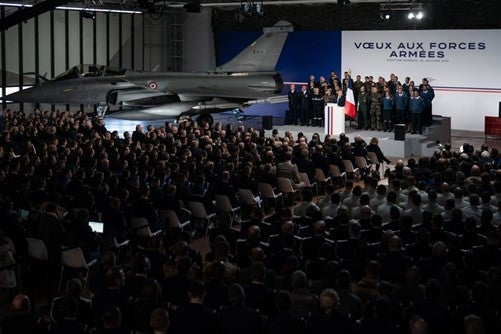French Parliament Approves Plans to Increase National Military Spending
On 13 July, France’s parliament approved President Emmanual Macron’s 413 billion Euro spending boost to the nation’s armed forces. A part of France’s 2024-2026 budget it was previously announced by the President in January, earlier in the year with him iterating the need to ensure “our freedom, our security, our prosperity, our place in the world.” It represents a military spending increase of more than one-third for the Republic, arguably brought about by conflict in Ukraine.
It should be noted this budget does not include any aid for Ukraine or indications of future aid. Officials have stated rather that “The Ukraine support is something that could evolve in time, and the president wanted to guarantee the evolution of this support could never impact our own capability buildup.” Instead, the majority of French support will emerge via the European Union’s European Peace Facility, an off-budget funding mechanism for actions regarding military and defense conducted by the European Union.
Specific Investment details as released by the French Ministry of Defence:
- €5 billion for intelligence and counterintelligence;
- €13 billion for overseas capabilities and initiatives;
- €5 billion for “drones,” including unmanned systems and remotely operated munitions, alongside the development of the Eurodrone medium-altitude, long-endurance UAV in development by Airbus for France, Spain, and Germany.
- €5 billion for surface-to-air defense capabilities;
- €16 billion for munitions, the modernization of long-range anti-ship missiles, as well as F321 heavy torpedoes and new surface-to-air and air-to-air interceptors (MBDA’s Aster-MICA and METEOR families, respectively);
- €49 billion for maintenance and conditional operations;
- €10 billion for innovative technology investments, including directed energy technology, swarming drones, and robotic capabilities;
- €6 billion for the space domain;
- €4 billion for cyber defense.
The Investment will target all areas of the French Armed Forces and France’s intelligence community. Namely Drone technology, long-range anti-ship missiles, and surface-to-air defense capabilities. For the French Navy, further funding for the PANG aircraft carrier project, alongside the scheduled arrival of 15 FDI Frigates by 2030. France’s ground forces intend to continue their modernization, focusing on the “Scorpion” overhaul program of its ground vehicles. While German and French intentions to develop a joint main battle tank will dominate spending and talks for the French Army.
Looking to the air force France intends to continue their goal of procuring more Dassault Rafale’s, expecting 32 new fighter jets from Dassault Aviation by 2030 and 2032. While development of a future next-generation fighter under the Future Combat Air System (FCAS) program between France, Spain, and Germany should see its first demonstration by 2027 as it benefits from French investment.
Furthermore, the air force will receive the ASMP-R medium air-to-surface missile, a nuclear-capable system operated on French fighter jets. While spending will also contribute towards developing the missile’s intended successor, the ASN4G, a nuclear-capable air-to-ground hypersonic cruise missile to be developed and built by French company ArianeGroup.
France intends to expand its ambitions in the emergent possible battleground of space too. Launching a new orbital space surveillance project, which using nanosatellites will identify potential threats to national security. Alongside this an on-orbit laser is being developed under the designation FLAMEHE and a ground-to-space laser system known as BLOOMLASE. France intends for both projects to be operational by the end of the decade.

